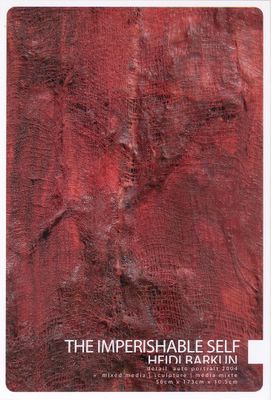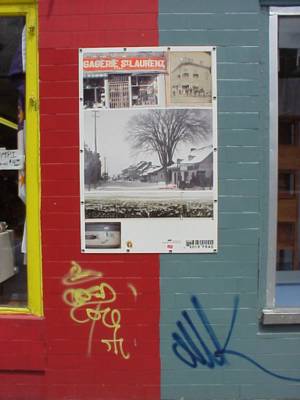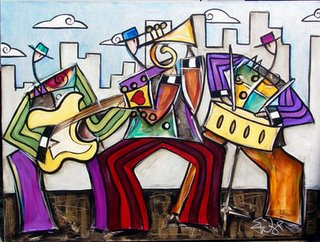Howdy!
If you'd like to listen while you read,
click here. (
stream it) [40:26 minutes, 38.8 MB] (Be forewarned, the windows were open while we spoke, and as a consequence there is an awful lot of background noise, sorry).
If you'd like to read and hear Part One,
click here. And if you like the interview, please consider making a donation to the gallery, thanks.
Eric Waugh: I'd like to produce less work, but, bigger work, hopefully, more important work. So there is some change in the air, I'd say maybe in ten years. But I think I'm still young. I'm 41 but I feel like I just started painting, like I'm in my early 20s.
Chris Hand: That's one thing I've realized, being in art does keep you feeling young.
Eric Waugh: Yeah, absolutely, absolutely. You know, I've got three young boys, trying to keep up with them, with all the music, and that kind of stuff. I think there is plenty of time for me to go that route, but I really want to get my art to a certain technical level first. I don't think people know who I am, but I'll actually be in an airport, and somebody will come up to me, "Are you Mr. Waugh?"
Chris Hand: That's one thing I was thinking, given how you've positioned yourself, you've got Celine Dion and the Cirque de Soeil that come from Québec, and within their fields, they're the large heavyweights, top sellers, and you, to me, should be as well known as they are. Which is not a slight at you aren't, but they are at a different level, and it must be extremely frustrating seeing stuff like that, then realizing, "Ugh!"
Eric Waugh: But again, it's all timing. For a good 12 years even though my work was selling all over the place- I didn't feel that I was just ready to come out, per se. But, after the World's Largest Painting, I said, "You know what? It's only going to help what I want to do in my bigger picture." People know who I am and I get more publicity, and my name gets bigger and I can sell my paintings for a little more, therefore I can give more money away when I do art auctions for charity, instead of raising $30,000 I can raise $60,000 because my prices are double. You know, I can do so much better for the big picture if I can get my name out, get some publicity, and get up to that Celine Dion level. That's in the works. For the first 12 years or so it wasn't a conscious effort. "OK, I have to do website and marketing, and here and there, and interviews and TV." You know, it wasn't planned. It was just, I'm gonna do my thing and see where it takes me. But now, there's a little more planning going on. There's a lot more things- you know, I have my distributor for my art, I have my live performance thing, I have Princess Cruises...I've been doing a little licensing by myself over the past few years: posters, the Kleenex box...the number one selling Kleenex box in the history of Kimberly Clarke, my design.
Chris Hand: Very nice.
Eric Waugh: It was running for close to ten years, and I think it stopped about a year and a half ago or so. But I've done a few journals, and stationary, and gift wrap, and things like that. So now I have a licensing agency out of New York that handles that stuff. They're looking for companies that could fit well with my art, do some tasteful connections there. What I really want to do is work with a specific company. I don't wanna just create X amount of images and say, "OK, put these out on coffee mugs." I want to create something specifically for that company, really sort of tailor make this image for them, for a little more of a connection. So that's happening. There is gonna be a lot of things happening. Which I'm very excited about...I'm finally at a very comfortable point in my life, you know, my family is great, we're well established, kids are in school... I no longer have to live paycheck to paycheck. Even though people think I'm this top selling artist, I've got money coming out of my sock. I'm running a 5,000 sq. ft. studio with people, I have expenses, I have camps, and schools and things so...it's hard. But I'm at a point now where I'm more comfortable, I'm more comfortable traveling. I didn't want to travel before, now I enjoy the travel, I enjoy the meeting people, I really love doing these festivals, art festivals, because you're getting 25, 30, 50,000 people coming through. It's almost like the gallery effect, or a museum effect, but where I'm actually getting to meet these people. They come, "Oh, Mr. Waugh, I really like your work, I collect it" or "I wanna collect it" or "This is the first time I'm seeing it" and they purchase it. That's a great thing. And to actually get out of the studio, and meet people who are buying your work. 'Cause for the longest time I sold to one guy, the distributor. I didn't even know where it went, I didn't even know at what galleries it was showing. I would get these emails: "Where can I find your work in Wisconsin?" "I don't know, contact these guys." And they're so amazed, they think I'm selling directly to the gallery, or something like that. So it's just great to get out, meet people, get feedback, you know, right away if I'm doing a painting, I finish the painting, people clap, right away. Most artists don't get that. So it's kinda cool. I think I have a pretty cool life.

Premiere II
Chris Hand: I keep wanting to do more and newer things, but when I sit back and think about it, I say to myself "Hold on, I already do tons of stuff!" Which helps to keep me focused.
Eric Waugh: I know, and there's only so many things you can do. But, it's kinda cool how things are coming together, it's not so here nor there. A schedule is actually made, and things can be planned, and it's not so flying by the seat of your pants. It's kinda neat that way.
Chris Hand: OK. I have one last question, a no brainer, given that your record is about to be broken or just has-
Eric Waugh: -he's working on it. Last week I got an email from my sister that was forwarded from my sister's father-in-law in Vancouver. And she says, "Take a look at this and then call me back." And for some reason I couldn't open up the attachment, I didn't know what is was and I didn't call her. And I guess Marie was talking to you, and you said you wanna ask him this question, "If you record is ever broken are you going to try to break it again?" And I thought, "That's a weird question," and then my mom calls me that night, and she says, "Did you know you're in the paper today in Vancouver?" I said, "What?" She said, "Yeah, someone is trying to break your record." And I thought she said when she read it 40,000 sq. meters. And I go, "This is ten times the size of what I did! Good luck to the guy." And then she sent me the actual clipping, and I'm looking at it and it's 4,000 sq. meters, and that's 120 more than I did, so I said "ok, he's going to be able to do this." so all the best. Marie's gonna get some information about this guy, I'll send him a "Good Luck" thing, and I wanna send him a piece of the world's largest painting, and maybe we can trade. Good luck to him, you know...that was a part of my life that was just incredible, such incredible highs and incredible lows. It was unbelievable. I was just so...you know, passionate about what I was doing I would have gone to any lengths to make it work. When I first started it I was going to do an 80,000 sq. ft. painting. It was going to be the "Hero" image, a replica of the "Hero" poster, I was going to incorporate everything in the poster, including the big green border and the writing along the bottom, everything. It was gonna be 80,000 sq. ft. So I set out to do my 80,00 sq. ft. painting, and a friend of mine calls up and says, "Eric have you seen the latest edition of Guinness Book?" "No." "Well, there's a 110,000 sq. ft. painting in it. Somebody beat you to it." And I'm like, "Argh! Oh man!" I got to this studio space that I was renting and I had built a 4,000 sq. ft. easel out of steel studs. And I ripped it all down. It was in a big pile. I didn't do anything to the painting, I came very close to just ripping it up or something. But I just took that easel and just ripped it off the wall. I was just so depressed, like, "What am I gonna do?" And then, it must have been like 24 hours and then it hit me, "Wait a minute here. Hundreds of people worked on that painting. What if I do it by myself?" I had stared this painting by myself. I was going to come up with a formula- you know, hire different artists, assistants, whatever. I was gonna get regular people as well. So I was like, "What if I do it by myself? There's no record for that." So I call Guinness Book people, and it's like, "Well, we'll have to have an official meeting on that and let you know." And a couple weeks went by and I got the official fax, it came through saying, "No problem, if you can do it by yourself, good luck to you." You know, five years later, painting it by myself in my spare time, trying to find money to pay for the canvas, I put in $40,000 of my own money to buy the canvas. ACE hardware donated paint, and this and that; I tried to get some big sponsors. FedEx to truck it down, which fell through at the last minute. But some great sponsors came in at the very end and pulled it off, we just pulled it off by the seat of our pants, more or less. I was literally...as I was painting the last few panels, the truck was being loaded, because it had to get there for November 29th, so it could be warehoused, and then get ready to be trucked to the Museum of Fine Arts of North Carolina. It was really just right down to the wire, and when we laid down the last panel, I had my family lay down the last panel, "Yay! Yay! Yay!" Everybody's clapping and the Guinness guy gives me the record and I'm like, "Fine, fine." And NBC is right into my face with this big camera, "How do you feel?" And then I just started bawling, because I thought about five years, and what I had to go through, the money, the sacrifice, the time from my family. I was just a mess.
Chris Hand: So then I take you're not trying to re-break it and come up with something else?
Eric Waugh: No, no. I have some other things in mind more in line with the live performances. But that was that. It was great, I have it documented, I have reels of footage, and that's that. It was a great time in my life and good luck to this guy, it's gonna be very exciting for him too. I'd actually like to go there when he unveils this thing. We're gonna try and get in touch with him and see what we can do. I've never been to Sweden so...
Chris Hand: Yeah, I just heard about it briefly on Monday, on the news or something, at which point was like, "Ah!" And at which point made sure that they mentioned you, and said OK, now I can relax.
Eric Waugh: It was on the news?
Chris Hand: Yeah, on CBC Radio Two.
Eric Waugh: And they mentioned my name?
Chris Hand: Yeah, he said something like, "Believe it or not, the current record holder is Canadian."
Eric Waugh: Cool, cool. Good luck to him. One of the major things that I get from live performances is that people actually get to see something created from beginning to end. They're just blown away by that. There's been a number of times when people will buy the blank canvas, even before it's painted, not knowing what they're going to get. But just the experience, just to be there, to be able to watch something like that is just amazing.
Chris Hand: That's one of the things that makes me realize I'm very lucky. For me, to do studio visits is a no brainer: that's a part of the job, it's what I do. Other people, they say, "You get to see stuff in the studio? Never thought of that. That sounds so cool." I say, "Come along! It is fun." But yeah, very few people see the any part of creation. I've seen HVW8, I haven't seen you. But I recognize that live creation isn't as much of an allure to me as getting to see the stuff no one else gets to see in the studio visits.
Eric Waugh: Exactly. I just think it's cool that so many people have the chance to see something created live, and when it's for charity... Right now, we're trying to work something out with Jazz at Lincon Center in New York, they're interested in having me, possibly with Wynton Marsalis, an event or something. There's a lot of things going on, but it's just tying them all together, timing, stuff like that...the "cool" factor. There is so many things people want me to do, but I've really got to make good use of my time...I met this hip hop/rap manager a few years ago in Atlanta. I'm telling him about all this charity stuff that I do. He's like, "Man, you're crazy to give so much of it away!" It's like, "Well, that's what I enjoy doing." He said, "Man, not makin' dollars, not makin' sense!" I said, "Well, you know, I'm making a bit of both, and that's good for me." Whatever we do, we try to really balance the charity with the making money thing.
Chris Hand: Yeah, it depends on priorities. It's like, yeah, I have a gallery and it supplies my beer habit, at which point I'm happy. I don't need to live on a mansion on the hill.
Eric Waugh: There's a lot of times where I just go for the charity event, and come back and I'm not making a nickel, I'm putting money out. That's fine because it all works out in the end. I think doing good is a good thing.
Chris Hand: Definitely.
Eric Waugh: People notice...it doesn't matter how you're doing good, you don't have to have to give money, you can give your time, you can give your knowledge, you can give a product. If you give it all comes back.
Chris Hand: Yeah it comes back, even larger and better. Now my last question. Is there anything I haven't asked that you would like me to ask?
Eric Waugh: Why did you want to interview me?.
Chris Hand: To get word even more out about you - that, to me, would be the best thing possible.
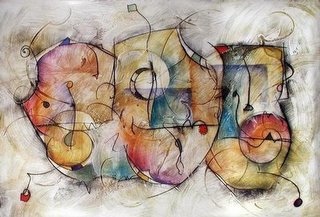
Bravo
Eric Waugh: Well, if you're willing to help! [laughs]
Chris Hand: I'm doing my best! I'm really surprised with the blog, how many people would read it every day, and one of my main things is sort of just getting visual art as mainstream as music, as books and so on.
Eric Waugh: Hello, why not?
Chris Hand: It's trying to change people's perception.
Eric Waugh: That's probably one of the reasons why I didn't want for people to know who I am. I want to do my paintings. There's like this perception that if you make some money as an artist, that's a bad, bad thing.
Chris Hand: No it isn't! Not at all!
Eric Waugh: But this is the feeling that you get, you can't do commercial, you can't do posters, you can't do this, you can't do that.
Chris Hand: Yes you can!
Eric Waugh: I know you can. When they speak of Celine Dion or someone like that, they're artists. Actors, they're artists. But they are all judged by record sales, by box office, by this, by that; it all has to do with money. But when it comes to a visual artist, they're not judged by how many paintings they made, how many posters they sold. There isn't an equivalent of a Grammys for art, for poster sales, for painting sales, for performances.
Chris Hand: You're right on that. What was you favorite performance?
Eric Waugh: I'd probably have to say Tony Bennett. The Rippingtons were kinda cool, too. It was a really nice beat and vibe going, the musicianship was outstanding...
Chris Hand: And who would you want to, if you could pick any musician, or musicians...?
Eric Waugh: That's hard. I did a performance at a techno club in Atlanta. It was just to a DJ, and I had the absolute best time, because of the beat, the vibe, the lighting and the smoke. It was crazy, and I was like, "What am I doing here?" But it was just really cool. So it's really not necessarily who it is, it's the feel of it, the beat and the sound, all that kind of stuff. Jazz at Lincoln Center, that interests me a lot because that's a very beautiful venue, and they have four different venues within the complex, so I know, the sound, the lighting, the stage, the people, the ambiance, everything is gonna be in place. I'm a little nervous about that, but I think it's gonna be great. But we'll probably start off doing some sort of fundraising event, which would be amazing, and then from that - you know, I don't want to be this performing artist, I want to be invited to some things...the Doobie Brothers was amazing. I got a call on a Thursday, saying, "Can you be in California on a Monday?" It's like, "Well, I have to be in Toronto for a show." And they said, "Well, let me tell you what's going on: you're gonna paint live to the Doobie Brothers." So I said, "Let me make a few calls, see if I can work it out." Just spur of the moment, spontaneous, that was kind of neat. I always like the Doobie Brothers, they've got a great sound. So, I don't necessarily want to be on the road with this choreographed thing. I just want it to take me where it takes me. I love painting to everything, from hip hop to jazz and blues and rock. I can't even name one artist that it's like, "Oh God, I'd love to paint with."
Chris Hand: OK, anyone you wouldn't want to paint with?
Eric Waugh: Yeah, that first band I painted with back at Mama May's [they laugh]. I even painted live to a belly dancer, believe it or not, with this Eastern/Indian music going on, that was kinda cool. I did a kinda different piece, a spicier piece than I would usually do. I love challenges. You know, I've done a lot of paintings...as an artist you want to be challenged in different ways, and that's one of the ways I like to be challenged: not knowing what I'm getting into, not knowing what the band will play, not knowing the music or beat. At the last minute, "Eric you're painting to a belly dancer." It's like, "What are you talking about?" Most artists would be like, "Forget it. I'm not painting to this." I'm very open to all kinds to things. I don't let anything...here's a hip hop, sort of piece, a little graffiti going on in the background, and this was very impromptu...there was sort of a hip hop/MTV sort of a thing happening in Atlanta, this was at the Swiss Hotel, they were coming to interview some band, I don't know who it is. And they saw what I was doing and they were very interested, and I had this blank canvas there. So they were like, "Can you do us a painting?" "Yeah." "Well, we'll get you on tonight at six." They had a hip-hop CD, they stuck it in the player, and I did my piece...Freddy Cole. That was cool, I had four canvases suspended from the ceiling, and see, I'm up here on the risers, up and down and up and down, a little bit of a performance thing. You know we auctioned it off for $14,000, all the money went to the Atlanta Children's Center, that's not bad for an hours work. I've gone through a few different styles along the way.
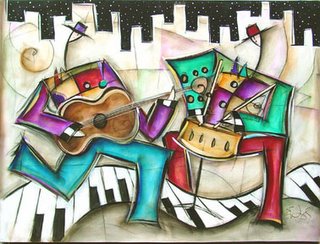
Strummin' & Drummin'
Chris Hand: Yeah, do the Carters represent other artists as well?
Eric Waugh: They were working with other artists, but now, they sort of committed themselves solely to me.
Chris Hand: The only reason I ask that is, have you ever thought of for a performance combining, and have somebody else, almost like a duet as opposed to you being solo on a painting?
Eric Waugh: You're saying couple people on a painting? Is that what you're saying?
Chris Hand: Yeah.
Eric Waugh: Never really thought of that.
Chris Hand: Because there, I've started doing a little bit of research on this as far as live performance painting, whether it's painting with music or without music. Like, HVW8 is a collective, and they have three people, and it is the sort of thing where each person has their own specific sort of role, and so somebody is doing background, and they start left to right. And then at some point somebody comes in and tosses in the faces-
Eric Waugh: How big are these paintings?
Chris Hand: About, five by five.
Eric Waugh: They're on canvas?
Chris Hand: Yep, on canvas.
Eric Waugh: Interesting. Do you know of something that's coming up?
Chris Hand: I can find out. Yeah, their studio is up on Mount Royal...I can definitely get you some information. Their style is very different from yours, their style is a lot more graffiti type stuff, with a lot of spray paint, and spray can effects.
Eric Waugh: Well let me know, I'd love to see them.
Chris Hand: I was just thinking in terms of if the Carters have other painters doing the same kind of stuff, send two of you out for one event.
Eric Waugh: Yeah, not really...the first artist they had, Martin Posey, he was amazing. He was this large, muscular black guy, he was 39, he actually died of a heart attack, after a live painting performance at the Hard Rock Cafe in Atlanta. He was pumping up with steroids and stuff like this before the show.
Chris Hand: You don't need steroids to do painting!
Eric Waugh: Oh, but he thought that's what he needed to get pumped up...he would be just dripping in sweat. He was working in oils, and doing this thing with rags and dancing. I'm not gonna do spins and stuff. He was really, you know, getting into it, and just because his build, he was just dripping. So the combination of the drugs and the high that you're on and the low when you finish, and the sweating, he was just blowing up his heart with paintings...

Piano Pleasure
Chris Hand: Do you know of anyone else out there doing similar...?
Eric Waugh: There are a few people, you know, I hear little bits here and there, you know, nobody on a large scale gets noticed,
Chris Hand: Here in Montreal, there is this thing called Peinture-en-direct. It sort of goes up and down, it was big four years ago, it was big ten years ago. The sort of thing where artists go into a bar and painting, and then auction it all off at the end, two hours of stuff like that. Pretty much Montreal artists painting for beer.
Eric Waugh: That's the hardest thing for me, I wish I could grab all these artists, and sit down with them and tell them the reality of the art world. There's so much more than trying to get it into one gallery on consignment. There's so much other things you could do with your art if you want to. You know if you don't want to, that's fine, but…I hope I answered all your questions.
Chris Hand: Yes, thank you very much, it has been a pleasure talking to you.
Eric Waugh: You're welcome
If you like what you heard, consider clicking on the button below, and donating some small change to Zeke's Gallery, thanks.















